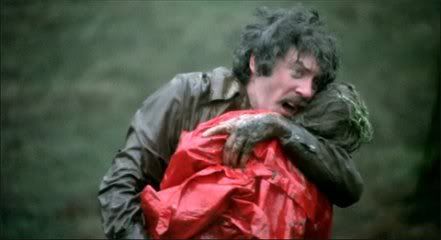I wish I didn't have to believe in prophecy.

In a career teeming with films full of startling originality, 1973's Don't Look Now stands as Nicolas Roeg's crowning achievement. Performance and Walkabout -- both of which Roeg shot himself -- definitely look like the films of a cinematographer turned director. They're full of startling images that sometimes stand apart from the story and, it must be said, occasionally distract from it. Don't Look Now (which was photographed by Anthony Richmond) is a film made by a director ready to harness images to serve the story and not the other way around. (Incidentally, Roeg must have liked Richmond's work here because he brought him back for his next two films and had previously used him as a special photographer on Walkabout and a focus puller on Far from the Madding Crowd.)
Don't Look Now stars Donald Sutherland and Julie Christie as grieving parents whose young daughter drowned on their country estate and who are in Venice while Sutherland is restoring a crumbling church. (The project goes under the heading of "Venice in Peril," which would be an apt alternate title for the film itself.) It isn't stated in the film how long it's been since the girl's death, but it hangs like a cloud over their marriage, which seems to need as much work as the church does. Things take a turn for the supernatural, though, when they run into a pair of sisters, one of whom (Hilary Mason) has second sight and claims to have seen their daughter. Christie is eager to believe, but Sutherland is highly skeptical despite the fact that he has shown some latent psychic talents himself.
Compared to some of his other films, the chronology in Don't Look Now is fairly straightforward, although there are numerous flash-forwards and flashbacks, but these are to individual shots that we're meant to sort out the connections between as opposed to entire scenes. Roeg maintains a sense of foreboding throughout, with its scenes of Venice closing down at the end of the tourist season and Pino Donaggio's melancholy score (the composer's first). And the shots from the opening sequence that keep cropping back -- the breaking glass, the ball landing in the water, the photographic slide getting smeared with red -- slowly build up a resonance and point the way toward the film's tragic conclusion.
The most justly celebrated scene in the film, though, comes when Sutherland and Christie make love, tentatively at first and then passionately -- and perhaps for the first time since the loss of their daughter. What's most eye-opening about the scene is the way it's cross-cut with the two of them getting dressed afterwards -- a strategy that Steven Soderbergh co-opted 25 years later to similar effect for the hotel liaison between George Clooney and Jennifer Lopez in Out of Sight. The end result in both cases is we've learned more about the characters than just the simple fact that they enjoy going to bed with each other. In Don't Look Now, we get the impression that Sutherland and Christie really are a married couple (as opposed to two movie stars going through the motions on a movie set) and that at one point they had an extremely healthy sex life. It's erotic and heartbreaking at the same time. I can't think of any director who does that quite like Roeg.